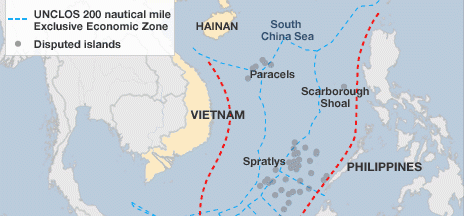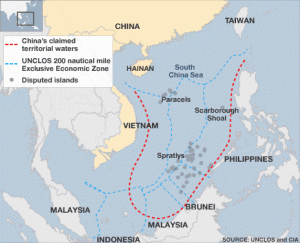Several countries lay overlapping claims to the energy-rich East and South China Seas. China claims the largest portion of the disputed territory, an area defined by the nine-dotted demarcation suggesting that Beijing lays claim to most of the South China Sea. Other major claimants in the area include the Philippines, Malaysia, Japan and Bruinei.
It was in 1947 when China issued the map detailing its claims. It wasn’t until 1951 that Beijing issued its first statement over the matter insisting that Hoang Sa (Paracel Islands), Truong Sa (Spratly Island) and Pratas Islands “were and always had been” part of Chinese territory. Along with its neighboring nations, Vietnam disputes China’s historical account, saying China had never claimed sovereignty over the islands before the 1940s. Adding to that, and with documents to back up its statements, Vietnam asserts it has actively ruled over both the Paracels and the Spratlys since the 17th Century.
Not only insisting the so-called 9-dotted line map, China also claims the East Sea a national sovereignty “core interest” and will not compromise, and will resort to force “if necessary” should it be violated by its neighbors. A Xinhua article published in August 2011 pronounced China’ “indisputable sovereignty” over three million square kilometers of East Sea waters, a point which the Chinese government, along with its national media, similarly repeatedly underscored. Such moves is clear to show how the country intends to monopolize the entire East Sea.
China’s Plot
It seems that China took varying efforts to win the tug-of-war over sovereignty of the contested territories. Among its initial moves to fulfill its ambition of coopting the East Sea, in 1996 China quickly approved an agreement ratifying the signing of the 1982 UN Convention on the Law of the Sea (UNCLOS), with the reserved clause “historical rights” belonging to China before the provisions of UNCLOS.
All school textbooks in its country were designed to inculcate among its children its assumed sovereignty of the entire East Sea.
But in 2012, China took more aggressive steps by announcing its establishment of the so-called Sansha City on Phu Lam Island of the Paracel archipelago of Vietnam, which they claim to have authority to administer both the Paracel and Spratly Islands of Vietnam. They then took a step further by placing the 9-dotted line in electronic passports which drew objection from many countries.
China beefed up its Coast Guard, the Fisheries Administration and the Marine Patrol forces and encouraged its fishermen to ply their trade in the remote fishing grounds in the overlapped areas or even in the waters of other countries.
In the early days of May 2104, the China National Offshore Oil Corporation (CNOOC) deployed the HD-981 oil rig in Vietnam’s continental shelf and exclusive economic zone, sparking strong protests from regional and international communities. Such is another of its many “status quo transformation” efforts.
Indeed, a plot by China to a systematic process to assert its ‘sovereignty’ over the disputed areas is in the works and they are expecting its neighbors in the region to resign themselves to its claims.
Is China Getting What It Wants?
China’s disputes with its neighbors over maritime boundaries have intensified in recent years. Anti-Chinese violence erupted in Vietnam last week over the illegal deployment of the oil rig 240 km (150 miles) off the coast of Vietnam’s waters.
Philippines have brought up its claims against China in the UN Tribunal, yet there was no participation from China over the proceedings. Just early this month however, a United Nations-backed arbitral tribunal has ordered China to submit its counter-argument to the memorial filed by the Philippines. This marks a development in the dispute.
The UNCLOS, of which China is a signatory, addresses matters such as sovereignty, rights of usage in maritime zones, and navigational rights.
Vietnam is now also considering taking China to international court to resolve its increasingly dangerous dispute over the contested waters. Despite China’s decades-old plot to claim ownership of almost the entirety of the contested territories, it remains to be seen whether they will actually succeed.

